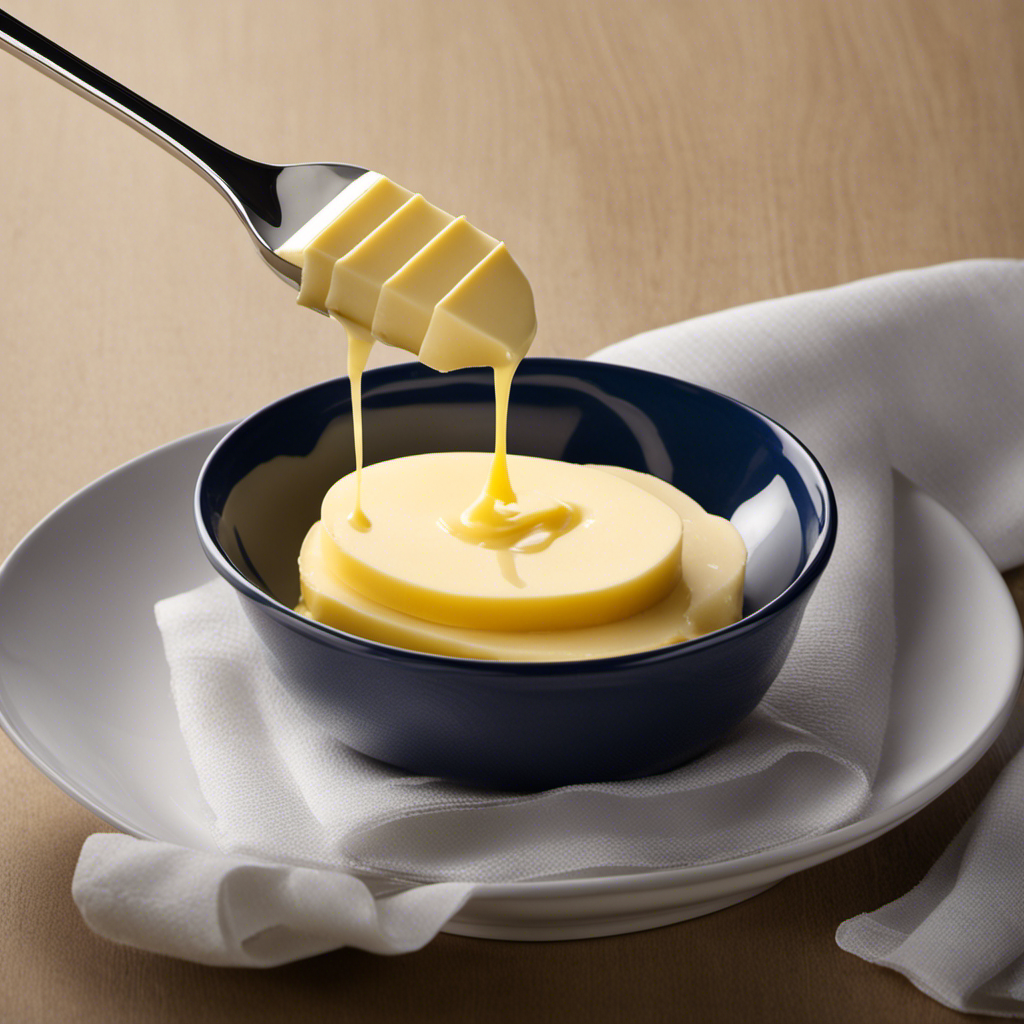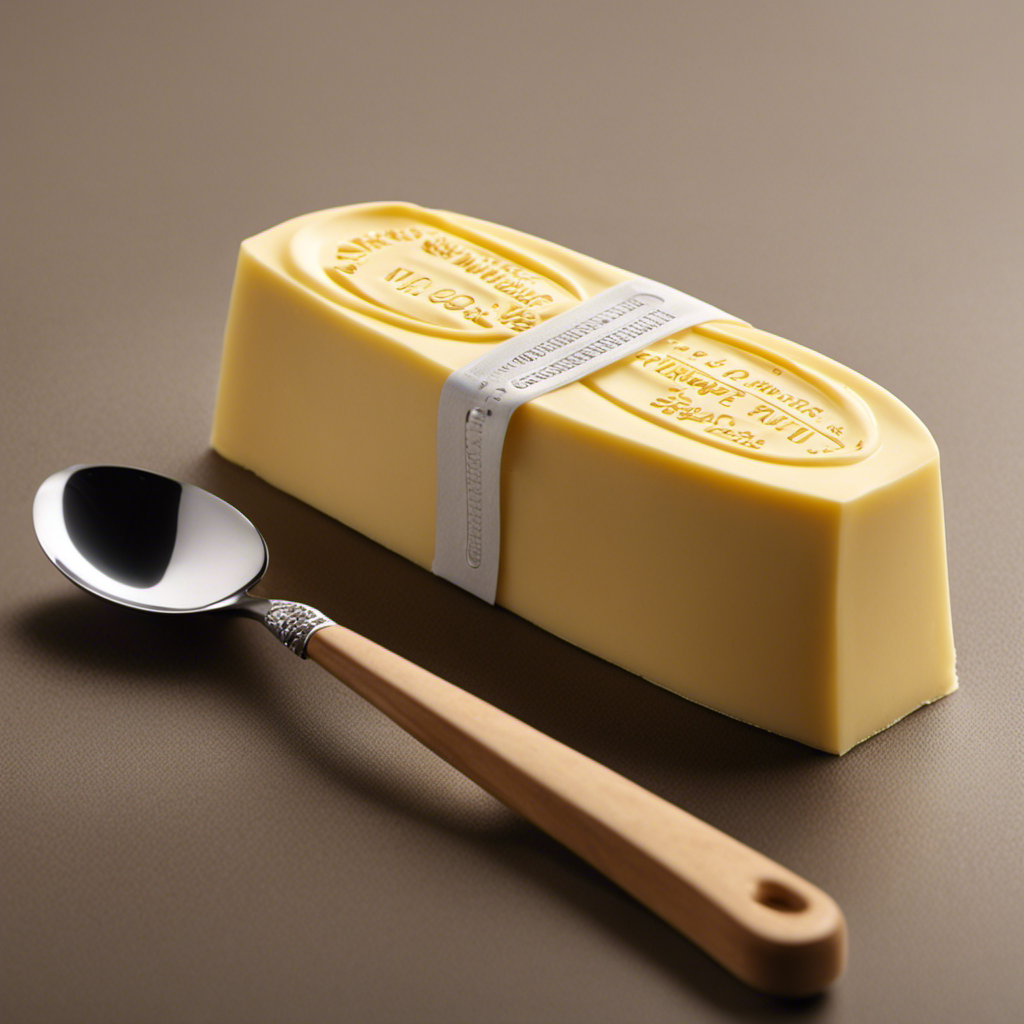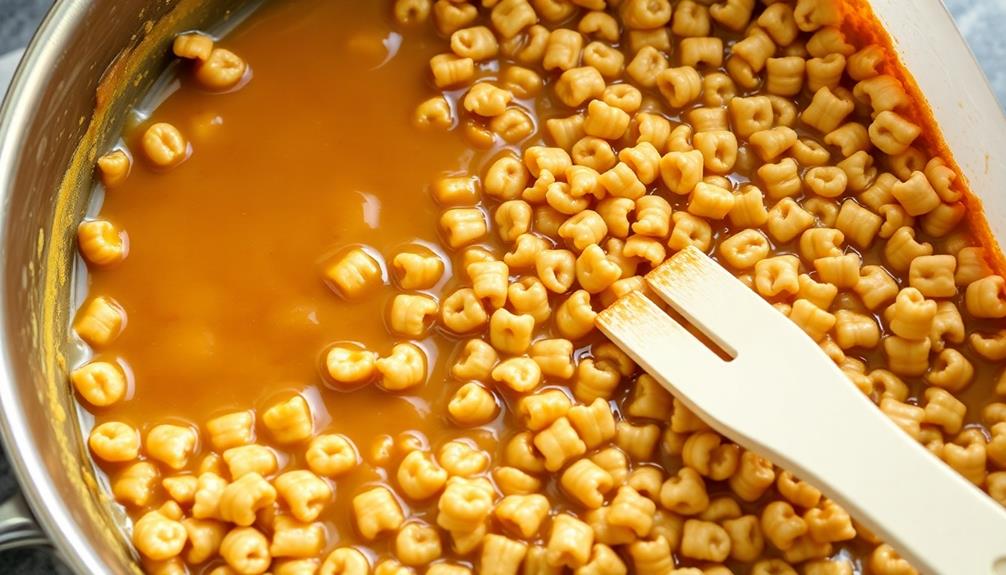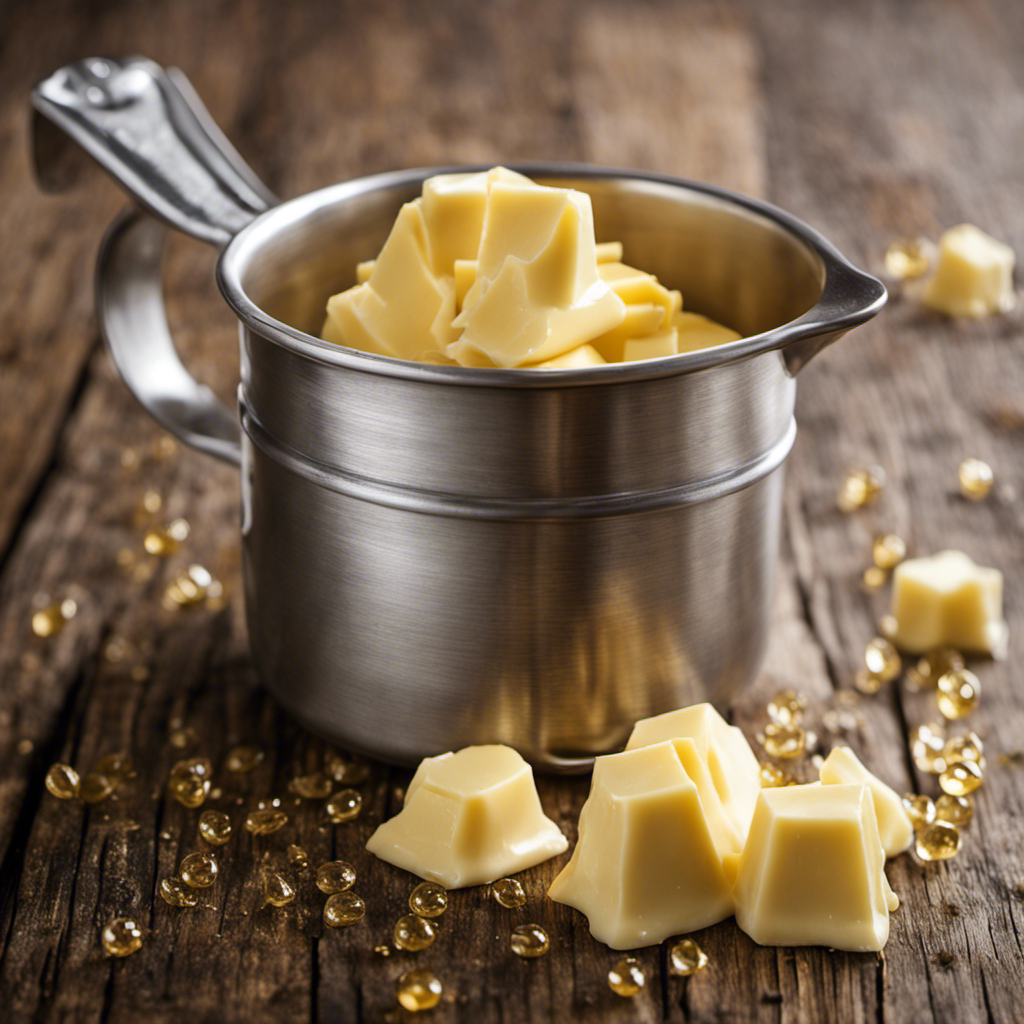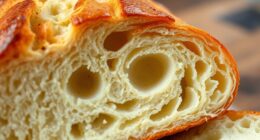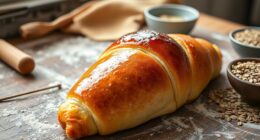I’ve always valued accuracy in cooking. Thus, when I encountered a recipe requiring 1/3 stick of butter, I was left pondering, “What exact amount of butter does that represent?”
Well, don’t worry, I’ve done the math and I’m here to share my findings. In this article, we’ll delve into the world of butter measurements, decode the mystery of 1/3 stick of butter, and even explore tips for storing this elusive fraction.
Get ready to butter up your baking skills!
Key Takeaways
- Butter can be measured in sticks, tablespoons, or cups.
- 1/3 stick of butter is approximately 2 2/3 tablespoons.
- Different methods can be used to measure 1/3 stick of butter.
- Alternative methods can be used to measure butter without a measuring cup.
Butter Measurement Basics
1/3 stick of butter is equivalent to approximately 2 2/3 tablespoons. Understanding butter measurements and converting them can be a bit confusing at first, but it’s essential knowledge for any avid baker or cook.
Butter is often measured in sticks, tablespoons, or cups, depending on the recipe. When a recipe calls for 1/3 stick of butter, it means you need to measure out approximately 2 2/3 tablespoons. To do this, you can use a tablespoon measure or cut a stick of butter into thirds and use one of the pieces.
It’s important to note that butter can be softened or melted, so make sure to adjust your measurements accordingly.
Now that we’ve covered the basics of butter measurements, let’s move on to understanding stick measurements and how they are commonly used in recipes.
Understanding Stick Measurements
To understand stick measurements, you can easily figure out the amount of butter you need. Stick measurements are a common way to measure butter in recipes, especially in the United States. One stick of butter is equal to 1/2 cup or 8 tablespoons. It is important to know this conversion so that you can measure butter accurately in your recipes. To make it even easier, here is a table that shows the different measurements for butter sticks:
| Stick of Butter | Cups | Tablespoons |
|---|---|---|
| 1 | 1/2 | 8 |
| 2 | 1 | 16 |
| 3 | 1 1/2 | 24 |
| 4 | 2 | 32 |
Decoding 1/3 Stick of Butter
When it comes to measuring butter, there are alternatives to using a full stick. One common measurement is 1/3 stick of butter, which can be used in various recipes.
In this discussion, we will explore different methods for measuring this amount of butter and delve into recipes that specifically call for 1/3 stick.
Butter Measurement Alternatives
If you don’t have a measuring cup, you can use alternative methods to measure your butter. When it comes to baking, accurate measurements are crucial for the perfect outcome. However, not everyone has a measuring cup on hand. Luckily, there are other ways to measure your butter without one. Here are some handy butter measurement equivalents that you can use:
| Measurement | Equivalent |
|---|---|
| 1 stick | 1/2 cup |
| 1/2 stick | 1/4 cup |
| 1/4 stick | 2 tablespoons |
| 1/8 stick | 1 tablespoon |
| 1/16 stick | 1/2 tablespoon |
These equivalents can help you measure your butter accurately, even if you don’t have a measuring cup. Just remember to refer to the packaging materials for the butter to determine the amount in each stick. With these alternatives, you can confidently bake delicious treats without worrying about not having a measuring cup.
Recipes Using 1/3 Stick
You can easily incorporate 1/3 stick measurements into your recipes for a touch of buttery goodness.
While it may seem like an odd measurement, there are common substitutions and creative uses for this amount of butter.
One of my favorite ways to use 1/3 stick of butter is to make a delicious garlic herb compound butter.
Simply soften the butter and mix in some minced garlic, chopped herbs like parsley or thyme, and a pinch of salt.
This compound butter can be spread on bread, melted over grilled meats, or used to sauté vegetables for added flavor.
Another creative use is to use 1/3 stick of butter to make a small batch of cookies or a single serving of buttery mashed potatoes.
The possibilities are endless when it comes to incorporating 1/3 stick measurements into your recipes!
Converting Stick Measurements
When it comes to butter stick conversions and fractional butter measurements, it’s important to have a clear understanding of how to accurately measure and convert butter in different forms.
Whether you’re following a recipe that calls for a specific amount of butter or trying to figure out how much butter is left in the fridge, knowing the conversions and measurements can make all the difference in your culinary adventures.
In this discussion, we will explore the various ways to convert butter measurements from sticks to cups, tablespoons, or grams, as well as how to deal with fractional butter measurements like 1/2 or 1/4 of a stick.
Butter Stick Conversions
To convert 1/3 stick of butter, simply multiply the measurement by 0.333. It’s important to know the equivalents of butter stick substitutes to ensure accurate measurements in recipes. Here is a helpful table showcasing common butter measurements:
| Butter Measurement | Equivalent in Cups | Equivalent in Tablespoons |
|---|---|---|
| 1/8 stick | 1 tablespoon | 3 teaspoons |
| 1/4 stick | 2 tablespoons | 4 teaspoons |
| 1/3 stick | 2 2/3 tablespoons | 8 teaspoons |
| 1/2 stick | 4 tablespoons | 12 teaspoons |
| 1 stick | 1/2 cup | 8 tablespoons |
Knowing these butter measurement equivalents allows for easy substitutions when necessary. Whether you’re halving a recipe or experimenting with healthier alternatives, understanding these conversions ensures your culinary creations turn out just right.
Fractional Butter Measurements
Fractional butter measurements can be converted easily using the helpful table provided.
When it comes to baking or cooking, accurate measurements are crucial. Sometimes, a recipe calls for a specific amount of butter in fractional measurements, like 1/2 or 1/3 of a stick.
Converting these measurements can be confusing, but with the right tools, it becomes a breeze. The table provides a clear breakdown of how many tablespoons each fractional measurement corresponds to.
For example, 1/3 stick of butter is equivalent to 5 1/3 tablespoons. This information is invaluable when following a recipe and ensures that your baked goods turn out just right.
Different Butter Packaging Options
You can find different packaging options for butter. As someone who loves cooking and baking, I always pay attention to the latest butter packaging trends. Here are four options that will surely evoke an emotional response in you:
1) Traditional Wrappers: There’s something nostalgic about unwrapping a stick of butter from its classic paper packaging. It brings back memories of childhood and homemade treats.
2) Convenient Tubs: Many brands now offer butter in tubs, making it easier to measure and spread. These resealable containers are perfect for those who use butter frequently.
3) Eco-Friendly Options: With sustainability becoming more important, some companies are now offering butter in eco-friendly packaging, such as compostable wrappers or recycled materials. It’s a great way to reduce waste and make a positive impact on the environment.
4) Vegan Butter Alternatives: For those who follow a plant-based diet, there are now vegan butter options available. These dairy-free alternatives come in various packaging, including tubs and wrappers, allowing everyone to enjoy the taste and texture of butter without the animal products.
How to Measure 1/3 Stick of Butter
When it comes to baking, accurate measurements are crucial for a successful outcome. However, not all recipes provide measurements in the form of tablespoons or cups, especially when it comes to butter.
In this discussion, I will explore butter measurement conversions and provide alternatives to measuring when you don’t have the right tools on hand.
Butter Measurement Conversions
To convert butter measurements, simply remember that 1/3 stick of butter is equal to about 2.7 tablespoons.
Here are some alternative butter measurement conversions that might surprise you:
-
1/2 cup of butter is equal to 1 stick or 8 tablespoons. This is the perfect measurement for baking delicious cookies or cakes.
-
1/4 cup of butter is equal to 4 tablespoons. Use this measurement when you want just the right amount of butter for sautéing vegetables or frying eggs.
-
1 tablespoon of butter is equal to 1/8 stick. This small amount of butter can add a rich and creamy flavor to your toast or steamed vegetables.
-
1 teaspoon of butter is equal to 1/3 tablespoon. Use this measurement when you need a touch of butter for spreading on your morning bagel or adding to a warm bowl of oatmeal.
With these butter measurement conversions, you can easily adjust your recipes to suit your needs and create delicious dishes every time.
Alternatives to Measuring
If you’re looking for options other than measuring, consider using spreads like margarine or coconut oil as alternatives.
Not only do these butter alternatives provide a different flavor profile, but they also offer a creative way to measure without the need for precise measurements.
When using margarine or coconut oil as a substitute for butter, you can simply eyeball the amount needed based on your preference.
For example, if a recipe calls for 1/3 stick of butter, you can estimate the same amount of margarine or coconut oil by using a spoon or knife to scoop out a similar portion.
This allows for flexibility in your measurements and encourages experimentation in the kitchen.
Common Recipes Using 1/3 Stick of Butter
There are many delicious recipes that call for 1/3 stick of butter. It’s a common ingredient that adds richness and flavor to dishes.
However, if you’re looking for alternatives or simply want to use less butter in your cooking, here are some tips that can help:
-
Substitute with healthier fats: Avocado, coconut oil, or Greek yogurt can be used as replacements for butter in certain recipes. They add a creamy texture and bring their own unique flavors to the dish.
-
Increase the use of herbs and spices: By using more herbs and spices in your recipes, you can enhance the flavors and reduce the need for butter. Fresh herbs like thyme, rosemary, and basil can add depth and complexity to your dishes.
-
Use broth or stock: Instead of sautéing ingredients in butter, try using vegetable or chicken broth. It adds moisture and flavor without the added fat.
-
Opt for cooking methods that require less butter: Grilling, steaming, and roasting are cooking techniques that require minimal butter. These methods allow the natural flavors of the ingredients to shine through without overpowering them with butter.
Adjusting Recipes for 1/3 Stick of Butter
Adjusting recipes for 1/3 of a stick of butter can be done by substituting with healthier fats, increasing the use of herbs and spices, using broth or stock, or opting for cooking methods that require less butter.
When I find a recipe that calls for 1/3 stick of butter, I usually prefer to use a healthier fat instead. Olive oil or avocado oil are great options that can add a rich flavor to dishes.
Another trick I use is to increase the use of herbs and spices. This not only adds more flavor to the dish but also helps to mask the absence of butter.
Additionally, using broth or stock can help to add moisture and richness to the recipe.
Lastly, opting for cooking methods like steaming or grilling can reduce the need for butter altogether.
Adjusting butter quantities in recipes is all about finding creative alternatives that still deliver delicious results.
Substituting 1/3 Stick of Butter in Recipes
When it comes to substituting 1/3 stick of butter in recipes, it’s important to consider both measuring accuracy and butter substitution options. Here are four options to consider:
-
Margarine: Margarine is a common butter substitute that can be used in equal amounts as butter. It has a similar texture and flavor, making it a great alternative in recipes.
-
Coconut oil: If you’re looking for a healthier option, coconut oil can be a great substitute. Use it in equal amounts as butter, but keep in mind that it may add a subtle coconut flavor to your dish.
-
Greek yogurt: For a lighter alternative, Greek yogurt can be used in place of butter. Use 1/2 cup of Greek yogurt for every 1/3 stick of butter in your recipe. It will add moisture and a tangy flavor to your dish.
-
Applesauce: If you’re looking to reduce the fat content in your recipe, try using unsweetened applesauce as a substitute. Use 1/2 cup of applesauce for every 1/3 stick of butter. It will add moisture and a subtle sweetness to your baked goods.
With these butter substitution options and careful measuring, you can successfully adapt your recipes to accommodate 1/3 stick of butter.
Tips for Storing 1/3 Stick of Butter
To store 1/3 stick of butter, you can use an airtight container or wrap it tightly in plastic wrap.
Storing butter properly is important to maintain its freshness and prevent it from absorbing odors from other foods in the fridge.
When I have a small amount of leftover butter, I prefer using an airtight container. This helps to keep the butter protected and prevents it from drying out.
If I don’t have a container, I’ll wrap it tightly in plastic wrap, making sure there are no air pockets. This method also works well for freezing butter.
Frequently Asked Questions About 1/3 Stick of Butter
If you’re unsure about the best way to store a 1/3 stick of butter, you can find answers to commonly asked questions here.
-
Butter Measurement Equivalents: Did you know that 1/3 stick of butter is equal to approximately 2 tablespoons? Knowing this measurement equivalent can help you easily adjust recipes that call for a full stick of butter.
-
Butter Measurement Tools: Investing in a kitchen scale or a butter cutter can make measuring and using 1/3 stick of butter a breeze. With a kitchen scale, you can accurately measure the exact amount of butter you need. A butter cutter, on the other hand, helps you cut the stick into convenient 1/3 portions.
-
Room Temperature Butter: To easily spread room temperature butter, leave a 1/3 stick of butter on the counter for about 30 minutes before use. This will ensure that the butter is soft and easy to work with.
-
Butter Storage: If you have leftover 1/3 stick of butter, wrap it tightly in parchment paper or plastic wrap and store it in an airtight container in the refrigerator. This will keep the butter fresh and prevent it from absorbing any odors in the fridge.
Frequently Asked Questions
Can I Use Margarine Instead of Butter in Recipes That Call for 1/3 Stick of Butter?
Sure, you can use margarine instead of butter in recipes that call for 1/3 stick of butter. However, keep in mind that butter and margarine have different properties, so the texture and taste may vary slightly.
How Do I Measure 1/3 Stick of Butter if I Don’t Have a Stick of Butter?
If you don’t have a stick of butter, measuring 1/3 stick can be a bit tricky. However, there are alternatives you can use, such as butter substitutes or measuring out 5 1/3 tablespoons.
Can I Use Oil Instead of 1/3 Stick of Butter in Recipes?
Sure, you can use oil as a substitute for 1/3 stick of butter in recipes. However, keep in mind that it may affect the taste and texture of the dish. Experiment and find what works best for you!
How Long Can I Store 1/3 Stick of Butter in the Refrigerator?
In the refrigerator, I can store 1/3 stick of butter for about 2-3 weeks. If I run out, I can use oil as a substitute in recipes. It’s important to check the recipe for specific measurements.
Are There Any Vegan Alternatives to 1/3 Stick of Butter?
There are several vegan butter alternatives and dairy-free substitutes available that can be used in place of 1/3 stick of butter. These options provide a cruelty-free and plant-based alternative for cooking and baking.
Conclusion
Well, who knew that such a tiny piece of butter could cause so much confusion? After delving into the world of butter measurements and decoding the enigma of a 1/3 stick of butter, it’s clear that this small portion can have a big impact on your culinary endeavors.
From adjusting recipes to finding the perfect substitute, we’ve explored it all. So next time you come across that elusive 1/3 stick of butter, remember, it may be small, but it’s mighty!



